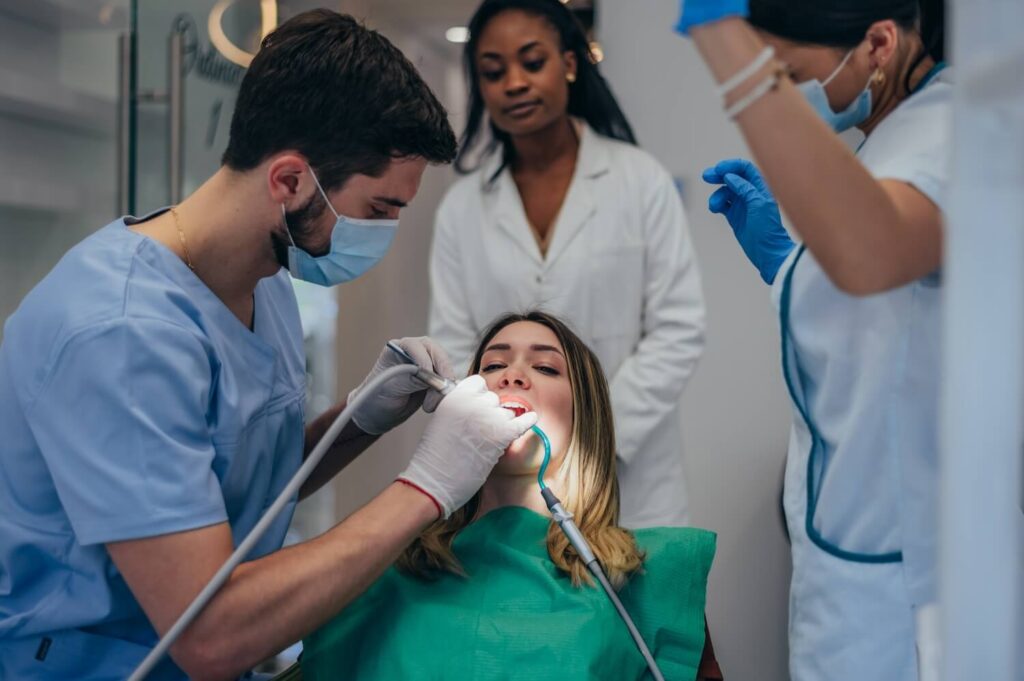Dental emergencies can occur suddenly and without warning, often causing pain, distress, and confusion about what to do next. Whether it’s a severe toothache, a knocked-out tooth, or an unexpected oral injury, knowing how to respond can mean the difference between saving your tooth and needing more complicated and expensive procedures. This comprehensive guide will delve deeper into common dental emergencies, how to manage them effectively, and when to seek professional help, ensuring that you are well-equipped to handle these situations.
Understanding Dental Emergencies
A dental emergency is any situation that requires immediate attention from a dental professional to alleviate pain, save a tooth, or prevent further complications. Recognizing the signs of a dental emergency is crucial for timely intervention. Here are some common types of dental emergencies:
- Toothaches: Severe or persistent pain can indicate an underlying issue, such as a cavity, infection, or gum disease.
- Knocked-out Tooth: This occurs when a tooth is dislodged due to trauma, such as a fall or sports injury. Time is critical in re-implanting a knocked-out tooth.
- Chipped or Cracked Tooth: Damage can range from minor chips to significant cracks that affect the tooth’s structure and integrity.
- Lost Filling or Crown: Losing a filling or crown can expose the tooth to bacteria and cause pain, requiring immediate attention.
- Abscessed Tooth: An infection at the root of a tooth can cause swelling, pain, and fever, necessitating urgent dental treatment.
- Gum Injury: Cuts, tears, or lacerations in the gums can result from accidents or dental procedures, requiring care to prevent infection.
Understanding these emergencies will help you recognize the seriousness of the situation and respond accordingly.
Care Steps to Take in a Dental Emergency
1. Stay Calm
In any emergency, staying calm is crucial. Panic can exacerbate the situation and lead to poor decision-making. Take a few deep breaths, and try to assess the situation logically. Remember that many dental emergencies can be managed effectively with the right approach.
2. Assess the Severity
Evaluate the situation to determine whether it is indeed a dental emergency. Ask yourself the following questions:
- Is there significant pain? Severe pain often indicates an urgent issue that needs attention.
- Is there visible damage? Look for broken, chipped, or dislodged teeth.
- Is there bleeding? Continuous bleeding from the gums or mouth may require immediate attention.
- Is there swelling? Swelling in the mouth, face, or jaw can indicate infection or injury.
If you answer yes to any of these questions, it may be time to seek professional treatment help.
3. First Aid Emergency Measures
Depending on the type of dental emergency, here are some first aid measures you can take:
Toothache
- Rinse with Warm Salt Water: Mix half a teaspoon of salt in a glass of warm water and rinse your mouth to reduce swelling and clean the area. Saltwater is an excellent natural antiseptic that can help alleviate inflammation.
- Pain Relief Medication: Over-the-counter pain relievers like ibuprofen or acetaminophen can help manage discomfort. Be sure to follow the dosage instructions on the label.
- Cold Compress: Apply a cold pack to the outside of your cheek for 15-20 minutes to reduce swelling and numb the pain.
Knocked-Out Tooth
- Handle the Tooth Carefully: Pick the tooth up by the crown (the chewing surface) and avoid touching the root. Handling it improperly can damage the root and hinder re-implantation.
- Rinse the Tooth: If dirty, gently rinse the tooth with water. Do not scrub or remove any attached tissue, as this could impact the chances of saving the tooth.
- Reinsert If Possible: If you can, gently place the tooth back into its socket. Make sure it is facing the right direction. If not, keep it moist by placing it in a container of milk or a saline solution. Alternatively, you can keep it in your own saliva by placing it between your gum and cheek.
- Seek Immediate Care: Time is critical; aim to see a dentist within 30 minutes to maximize the chances of saving the tooth.
Chipped or Cracked Tooth
- Rinse Your Mouth: Use warm salt water to clean the area and reduce the risk of infection.
- Apply a Cold Compress: This can help reduce swelling and discomfort in the affected area.
- Avoid Certain Foods: Stay away from hard, crunchy, or sticky foods until you can see a dentist. Chewing on these types of foods can exacerbate the damage.
Lost Filling or Crown
- Use Dental Cement: Over-the-counter dental cement can temporarily secure the crown or filling until you can see a dentist. These cements are often available at pharmacies.
- Avoid Hard Foods: Stick to soft foods to prevent further damage to the tooth.
Abscessed Tooth
- Rinse with Salt Water: This can help clean the area and reduce discomfort. Salt water is effective in flushing out bacteria and preventing further infection.
- Pain Relief: Take over-the-counter pain medications as needed to manage discomfort.
- Seek Immediate Attention: An abscess can lead to serious complications if left untreated, including the spread of infection.
Gum Injury
- Control Bleeding: Apply gentle pressure with a clean cloth or gauze until bleeding stops. If bleeding persists, elevate the injured area if possible.
- Rinse with Warm Salt Water: This can help clean the area and promote healing.
- Seek Professional Help: Depending on the severity of the injury, you may need stitches or other treatment. A dentist can assess the damage and provide the necessary care.
4. When to Seek Professional Emergency Help
While some dental emergencies can be managed at home, many require professional intervention. Here are guidelines for when to seek help:
- Severe Pain: If over-the-counter medications do not alleviate your pain, seek dental care as soon as possible.
- Injury to Teeth or Gums: Any significant damage to teeth or soft tissue should be evaluated by a dentist, especially if the injury is accompanied by severe pain or bleeding.
- Persistent Bleeding: If bleeding does not stop after 10 minutes of applying pressure, contact a dentist or visit the emergency room for further evaluation.
- Swelling or Fever: These symptoms can indicate an infection that requires immediate treatment. Swelling can also signify a potential abscess, which necessitates prompt care.
- Multiple Issues: If you experience multiple symptoms simultaneously, do not hesitate to seek professional help. Prompt treatment can prevent complications and ensure your oral health is preserved.
5. Finding a Dental Provider in an Emergency
In the event of a dental emergency, it’s essential to have a plan for finding a dentist. Here are some tips to help you locate a reliable dental provider:
- Identify Local Dentists: Research dental providers in your area beforehand, noting those that offer emergency services. Many dentists have emergency contact information on their websites.
- Ask for Recommendations: Friends, family, or your general practitioner may provide recommendations for reliable dentists who handle emergencies.
- Check for After-Hours Care: Some dental practices offer after-hours services or have an on-call dentist for emergencies. Having this information on hand can save you valuable time in a crisis.
- Review Online Reviews: Websites like Yelp or Google Reviews can give you insight into other patients’ experiences with local dental practices.
6. Preventing Dental Emergencies
While not all dental emergencies are preventable, several steps can minimize your risk:
- Maintain Regular Dental Check-Ups: Regular visits to your dentist can help identify potential problems before they escalate into emergencies. Professional cleanings and examinations are crucial for maintaining oral health.
- Practice Good Oral Hygiene: Brush and floss regularly to reduce the risk of cavities and gum disease. Use fluoride toothpaste and mouthwash for added protection.
- Wear a Mouthguard: If you play contact sports or engage in activities that risk dental injury, wearing a mouthguard can protect your teeth from trauma. Custom mouthguards offer the best fit and protection.
- Avoid Hard Foods: Be cautious with hard candies, ice, and other foods that can chip or crack teeth. Consider cutting harder foods into smaller pieces before eating.
- Limit Sugary Foods and Drinks: Reducing sugar intake can help prevent cavities and other dental issues. Choose healthier snacks, and opt for water or milk instead of sugary beverages.
7. Understanding Your Insurance and Payment Options
Dental emergencies can be expensive, so understanding your insurance coverage and payment options is essential:
- Check Your Insurance Policy: Review your dental insurance policy to understand what emergencies are covered. Many plans cover a portion of emergency visits and treatments.
- Ask About Payment Plans: Some dental offices offer payment plans for emergency procedures, making it easier to manage costs without financial strain.
- Consider Dental Discount Plans: If you don’t have insurance, consider enrolling in a dental discount plan, which can help reduce out-of-pocket expenses. These plans typically provide discounts on services at participating dental providers.
- Inquire About Financing Options: Some dental offices partner with financing companies to offer patients low-interest payment plans, allowing for more manageable payments.
8. Dealing with Anxiety and Fear in an Emergency
Dental emergencies can be particularly stressful, especially for individuals with dental anxiety. Here are some strategies to help manage anxiety during a dental emergency:
- Communicate Your Fears: Let your dentist or dental staff know about your anxiety. They can provide extra support and reassurance during your visit.
- Practice Relaxation Techniques: Deep breathing, visualization, or mindfulness can help calm your nerves. Consider practicing these techniques before and during your appointment.
- Bring a Support Person: Having a friend or family member accompany you to the dentist can provide comfort and support during your visit.
- Consider Sedation Options: If you have severe anxiety, discuss sedation options with your dentist. Many practices offer sedation dentistry to help patients feel more comfortable during procedures.
Conclusion
Dental emergencies can be daunting, but knowing how to respond can significantly reduce the stress and impact of these situations. By staying calm, assessing the severity of the issue, and taking the appropriate first aid measures, you can manage the situation effectively. Remember, seeking professional help promptly is often the key to preserving your dental health. Ensure you have a plan in place for emergencies, including knowing who to call and having your insurance information readily available.
In summary, being prepared for dental emergencies not only enhances your confidence in handling them but also safeguards your oral health for the long term. Remember that prevention is equally important—maintaining regular dental check-ups and practicing good oral hygiene can minimize your risk of encountering dental emergencies in the first place.


